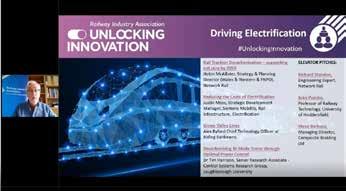24
FEATURE
KeTech update
Connected Driver Advisory System
I
n December 2019 (issue 180), Rail Engineer reported on a visit to KeTech Systems in Preston to hear about its innovative, truly connected real-time information systems. With the recent update to the industry Rail Technical Strategy (RTS), Rail Engineer recently met up again with KeTech to find out about the latest developments and discover how some of the RTS’ future vision for the development and deployment of technology in rail is being delivered today. Connected Driver Advisory System (C-DAS) is, as the name suggests, a driver advisory system with a communication link to connect with other information sources. It advises the driver with easy-to-understand realtime information to assist the efficient regulation of the speed profile and to avoid unnecessary braking. Avoiding unnecessary braking and acceleration saves energy, provides a smoother journey for passengers, and assists asset life with less ‘wear and tear’ for both track and rolling stock. C-DAS also helps to ensure a train arrives at any junction in time to avoid timetable conflicts with other trains. Passenger comfort and journey perception affect the rating of passenger satisfaction and how people value their rail experience. A journey that is subject to hard braking, frequent acceleration and stops for conflicts (especially just short of the destination) detracts from the passenger rail experience. There is a saying in the rail industry that “A moving train is a happy train”. KeTech’s C-DAS contributes to this objective, with better passenger satisfaction, lower cost, and environmental benefits. C-DAS ‘advises’ a driver, so it does not require a high safety integrity, which can drive up the cost of other train and signalling systems significantly. Safety is ensured by the train’s normal onboard control and braking system, and the lineside signalling system. The communications link provides aggregated real-time updates of information from systems such as the signalling system, Darwin (the rail industry’s official train running information engine) and others, which provide real-time arrival and departure predictions, platform numbers, delay estimates, schedule changes and cancellations. Unlike other C-DAS systems, the KeTech system uses reliable signalling-derived information supplemented by Global Navigation Satellite System (GNSS) information. Some other C-DAS systems only use GNSS, which cannot provide real-time dynamic updates and can also be blocked by deep cuttings and tunnels. An energy-efficient speed profile is advised to the driver to help meet the timetable, which considers timing points, line speeds, speed restrictions, and the train’s characteristics and capabilities. The driver is advised if the train is behind time and if the line and train speed limits are capable of a higher speed, or, if the train is running early, a more efficient speed profile, both to save energy and wear and tear on the train.
Rail Engineer | Issue 187 | November/December 2020










